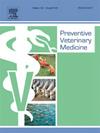Within-herd mathematical modeling of Mycobacterium avium subspecies paratuberculosis to assess the effectiveness of alternative intervention methods
IF 2.2
2区 农林科学
Q1 VETERINARY SCIENCES
引用次数: 0
Abstract
Johne’s disease (JD) in cattle is caused by Mycobacterium avium subspecies paratuberculosis (MAP) and is characterized by chronic, progressive enteritis that can lead to substantial weight loss, severe diarrhea, and eventual death. Economic losses due to JD are primarily driven by reduced milk production in subclinical and clinically infected cows, but also include reduced value when sold to slaughter, and costs associated with premature culling. Controlling the transmission of JD within a dairy herd can be achieved through proactive calf management practices and reactive test-based culling. While effective, test-and-cull interventions have the potential to result in net economic losses, particularly when the intervention includes culling of low-shedding cattle. Proactive calf management practices have been observed to be effective at controlling within-herd JD prevalence. However, assessing the magnitude of effect of interventions in observational and experimental studies can be difficult due to the pathogenesis of MAP and may take many years of data to provide meaningful results. The limitations of studying JD in nature presents an opportunity to use mathematical modelling techniques to assess the effectiveness of various interventions on the simulated within-herd disease dynamics of JD. The objectives of this study were to build a within-herd compartmental disease model of JD and assess the effectiveness of three interventions: 1) strategic insemination of test-positive low-shedding adult cattle to preferentially breed beef calves, 2) using separate calving areas for low- and high-shedding dams, and 3) test-based culling of low- and high-shedding cows. Model outcomes were compared to a base case model (i.e., no interventions) under four endemic within-herd prevalences. In general, simulations of test-based culling performed best at reducing long-term within-herd prevalence of JD. Strategic insemination and separate calving area interventions were both effective and performed similarly to one another, but even when combined were not as effective as test-and-cull alone. Finally, the results from the separate calving area intervention model suggest that increased dam-calf contact time would not result in a substantial increased within-herd prevalence. Given that some of the modelled populations in this study are very small and prevalence is very low, further work is needed to assess these interventions using discrete, stochastic methods, which may result in different outcomes.
禽分枝杆菌副结核亚种的群内数学建模以评估替代干预方法的有效性
牛的约翰氏病(JD)是由鸟分枝杆菌亚种副结核(MAP)引起的,其特征是慢性进行性肠炎,可导致体重大幅下降、严重腹泻和最终死亡。JD造成的经济损失主要是由亚临床和临床感染奶牛的产奶量减少造成的,但也包括出售到屠宰场时价值下降以及与过早扑杀相关的成本。通过积极的小牛管理实践和基于测试的反应性扑杀,可以控制JD在奶牛群中的传播。测试和淘汰干预措施虽然有效,但有可能造成净经济损失,特别是当干预措施包括淘汰低脱落牛时。积极的小牛管理实践已被观察到在控制牛群JD患病率方面是有效的。然而,由于MAP的发病机制,在观察性和实验性研究中评估干预措施的影响程度可能很困难,并且可能需要多年的数据才能提供有意义的结果。在自然界中研究JD的局限性提供了一个机会,可以使用数学建模技术来评估各种干预措施对JD的模拟群内疾病动态的有效性。本研究的目的是建立JD的群内隔间疾病模型,并评估三种干预措施的有效性:1)对检测阳性的低脱落成年牛进行策略性授精,以优先繁殖肉牛;2)在不同的产犊区建立低和高脱落的堤坝;3)基于测试的低和高脱落奶牛的剔除。将模型结果与基本情况模型(即无干预措施)在四种兽群内流行情况下进行比较。一般来说,基于测试的扑杀模拟在降低JD长期流行方面表现最好。策略性人工授精和单独的产犊区干预都是有效的,并且彼此的效果相似,但即使结合起来也不如单独的测试和筛选有效。最后,单独产犊区干预模型的结果表明,增加坝-小牛接触时间不会导致群内患病率大幅增加。鉴于本研究中的一些模型人群非常小,患病率非常低,需要进一步的工作来评估这些干预措施,使用离散的,随机的方法,这可能会导致不同的结果。
本文章由计算机程序翻译,如有差异,请以英文原文为准。
求助全文
约1分钟内获得全文
求助全文
来源期刊

Preventive veterinary medicine
农林科学-兽医学
CiteScore
5.60
自引率
7.70%
发文量
184
审稿时长
3 months
期刊介绍:
Preventive Veterinary Medicine is one of the leading international resources for scientific reports on animal health programs and preventive veterinary medicine. The journal follows the guidelines for standardizing and strengthening the reporting of biomedical research which are available from the CONSORT, MOOSE, PRISMA, REFLECT, STARD, and STROBE statements. The journal focuses on:
Epidemiology of health events relevant to domestic and wild animals;
Economic impacts of epidemic and endemic animal and zoonotic diseases;
Latest methods and approaches in veterinary epidemiology;
Disease and infection control or eradication measures;
The "One Health" concept and the relationships between veterinary medicine, human health, animal-production systems, and the environment;
Development of new techniques in surveillance systems and diagnosis;
Evaluation and control of diseases in animal populations.
 求助内容:
求助内容: 应助结果提醒方式:
应助结果提醒方式:


